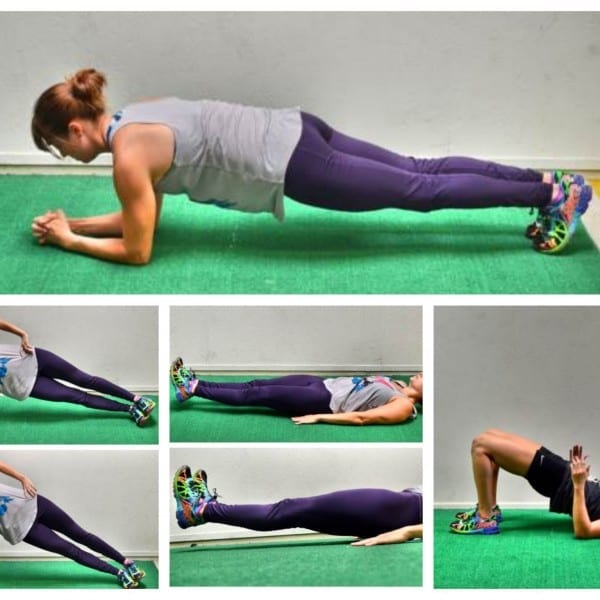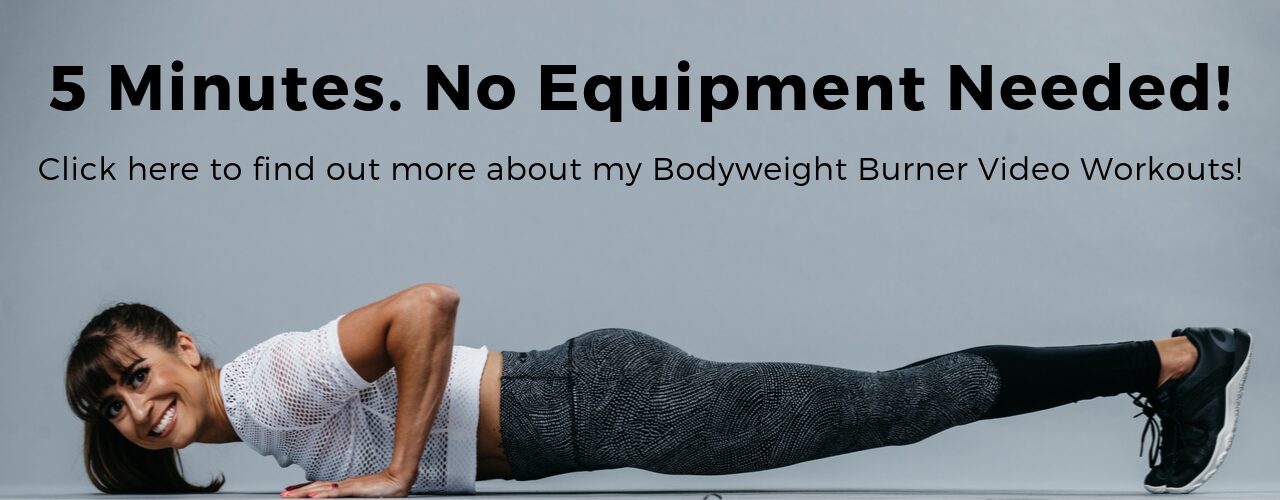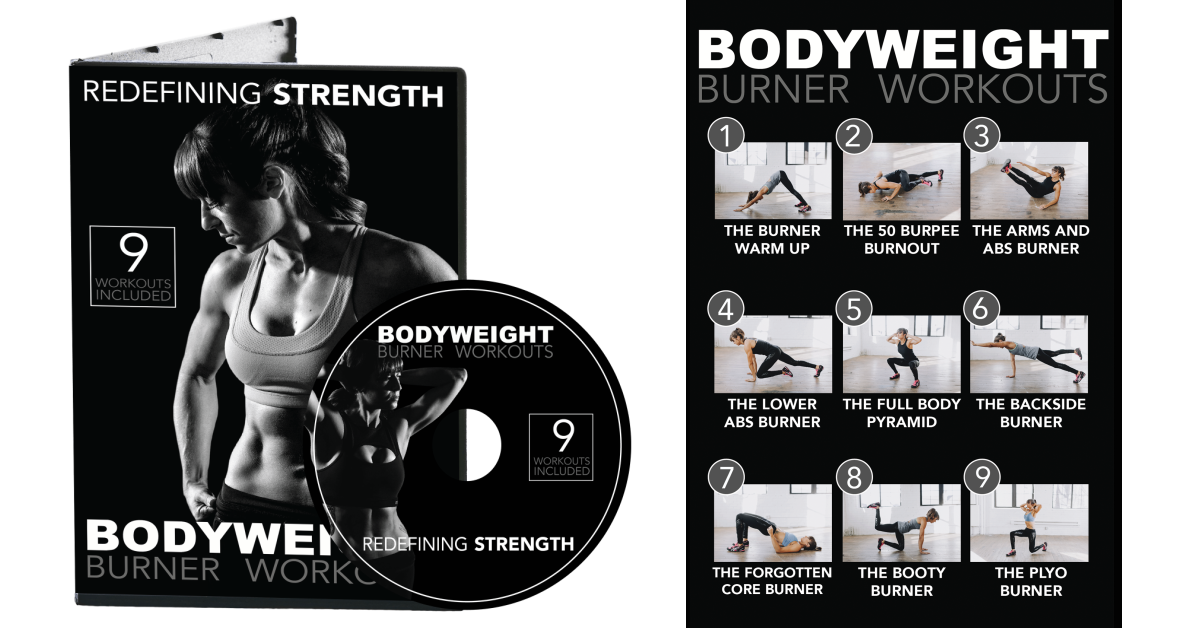Planks are always a popular exercise. And with good reason. They are a great core exercise!
The problem is…it has become a competition to hold a plank the longest. When how long you can hold a plank isn’t near as important as your ability to properly engage and contract the muscles of your core intensely.
It is a much better test of core strength to challenge yourself to engage the muscles of your core so intensely that you create “shakeage” within seconds of starting the plank rather than compensating just to hold longer. If you can engage your muscles so intensely that they are shaking, you will be able to use your core and recruit the muscles of your core more efficiently during other movements.
Developing proper core strength and learning how to properly engage the muscles of your core is why you should truly be including planks in your workout routine. You want to use them to strengthen your mind-body connection!
Below are some tips to help you get the most out of the Basic Plank as well as a few basic variations and a great core burn out workout.
Perfecting The Plank – Tips To Help Improve Your Form
Getting the most out of the plank is all about improving your mind-body connection. Can you focus and concentrate on engaging and contracting the muscles of your core? Or do you simple mimic the plank position and go through the motions of holding the position.
If you want to truly benefit from the plank, you need to focus and think about contracting the correct muscles.
Below are some steps and tips to help you get the most out of the basic Forearm Front Plank.
Basic Forearm Front Plank Form

Set your elbows underneath your shoulders and lift up into a plank with your feet and legs together. It is important that your elbows are underneath your shoulders so that you can properly engage your back and the muscles around your ribs. It is also important that your feet and legs are together so that you can engage your inner thighs.
Once in this position, think about creating a nice straight line from your head, down your spine, to your heels. Make sure that you then drive back through your heels and that, when you do, your shoulders are still aligned over your elbows. If they aren’t, adjust.
With your body in a nice straight line, being to focus on engaging all the correct muscles to create tension and “shakeage” throughout your core. You want to engage so hard that your body starts to shake not relax as you hold so that you can hold longer.
Begin by driving back through your heels as you flex your quads, engage your glutes and squeeze your legs together.
Then move to focus on your abs as you keep your lower body engaged. Brace your abs by almost trying to tuck your hips under and draw your ribs down toward your hips.
As you brace your abs, don’t let your upper back round. Pull your shoulders down so that you aren’t shrugging by using your back and the muscles around your ribs to keep your back flat and shoulders down. You can even think a bit about pulling your elbows down and back toward your hips as you hold if that helps engage your lats to support your shoulders.
Now with everything engaged and your body in a nice straight line, HOLD.
Keep thinking about the muscles that should be working and constantly assess or even try to tighten them further.
You should not feel your low back. You should not feel only your shoulders working. Engage your core. Feel your abs braced and your back helping to support your shoulders. Feel your legs engage to help maintain the nice straight line.
If you begin to shake, good!
Don’t worry about how long you hold, simply try to hold as hard as possible!
Holding a plank this way should be challenging for 10 seconds so you don’t need a long time to feel this working. And you should feel everything really shaking when you hold for the 30 second interval in the Core Burn Out!
The same rules apply to Side Planks, Lower Ab Planks and even Glute Bridges. Never are you just holding and trying to make it through the time. You always want to concentrate on engaging and working the correct muscles.
This helps you improve your mind-body connection so that you can not only truly strengthen your core, but you can learn how to engage and activate your core correctly when you do compound exercises with heavier loads.
Basic Forearm Side Plank Form

Like with the Forearm Front Plank, you want to concentrate on engaging the correct muscles not simply holding as long as possible. You want to make sure that you really feel this all the way down your side on bottom.
Set up on your forearm and elbow with your elbow right underneath your shoulder and your legs out straight. With all planks, beginners can and should do them from their knees if they struggle to maintain proper form. Lift up onto the sides of your feet or the outside of your bottom foot if your feet are stacked.
You want to make sure your elbow is underneath your shoulder so that you can use your back and the muscles along your ribs to support your shoulder. Almost feel like you are not only pressing your elbow down into the ground but also pulling it down toward your hip to engage the side of your back.
Focus on lifting your bottom side up off the ground as you hold. You are going to engage all the way down that side. You should feel the side of your back and along your ribs working to lift. You should feel your oblique and the outside of your butt also working to keep your hip up. And you may even feel the outside of your leg working. Use everything not just your abs or your shoulder to lift your bottom side up off the ground.
Then also engage your back and squeeze your butt to keep your body from rotating toward the ground. You do not want your chest rotating toward the ground or your butt sitting back. Engaging your back and butt will also help keep you in a nice straight line.
Hold and constantly check to make sure you are working to lift yourself up off the ground without rotating or rounding forward. Also make sure you drive through the sides of your feet and don’t start to slide so that your elbow ends up way beyond your shoulder.
It is very important with the Side Plank that you feel all down the side working and not simply your lower back or your shoulder. Reaching the top hand up toward the ceiling can also help remind you to keep your chest open. Do not touch that hand down to the ground as you hold.
Helpful Exercises To Improve Your Plank Form
The forearm plank variations above, both the front and side variations, are the basic plank moves you should start with.
But if you are still finding it difficult to engage your core and get all the muscles activated and working properly, you may want to regress the movement further first. This could simply mean doing them both from your knees or it could mean starting with even more basic movements like the Kneeling Plank or a variation of the Pelvic Tilt.
The Kneeling Plank and Pelvic Tilt are great places to start as they require less strength and engage fewer muscles at once, making it easier to focus in on the core muscles that should be working. These can also allow you to build the strength and mind-body connection to improve your planks.
Kneeling Plank – If you struggle to focus on engaging everything between your shoulders to your knees as you hold the Forearm Front Plank, this is a great place to start. It allows you to concentrate on each muscles and build your mind-body connection with a slightly easier movement. It is also a great way to teach you to engage your back and even the muscles along your ribs to protect your shoulders during the plank.
It is also a great place for even advanced exercisers to return to make sure everything is working properly. And if you have a partner press up on your hands during the movement, you can make it extremely tough and challenging!
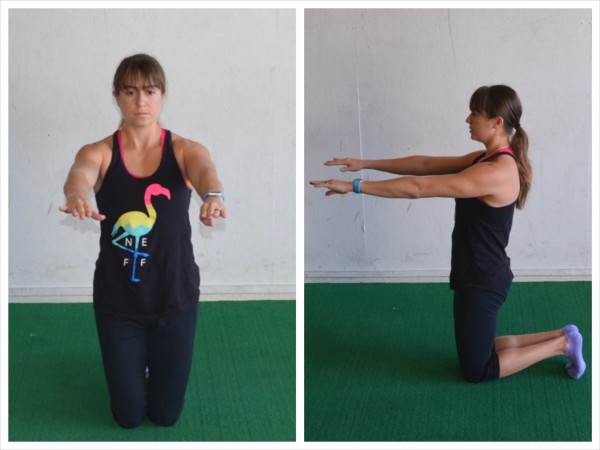
To do the Kneeling Plank, start on your knees with your knees together and feet flexed behind you. Kneel nice and tall and reach your arms out in front of you at about shoulder height.
Press your chest out and draw your shoulder blades down and together as you brace your abs and engage your glutes. Squeeze your legs together and flex your quads.
Then keeping your core engaged and your arms out at shoulder height, begin to “press down” with your hands. This will engage your lats and back like you should with the plank.
Engage as hard as you can for 10-15 seconds and then relax. If you have a partner, have them place their hands under yours so that you can press down as they provide some resistance to make your back and abs work even harder.
Pelvic Tilt Progression – During the plank, you can use the Pelvic Tilt to help you engage your abs properly and prevent your lower back from taking over. This is a great move for anyone that feels their low back constantly trying to take over during core exercises, including Glute Bridges.
There are a number of levels to the Pelvic Tilt Progression. Make sure to select one that allows you to keep your abs engaged and not let your low back take over.
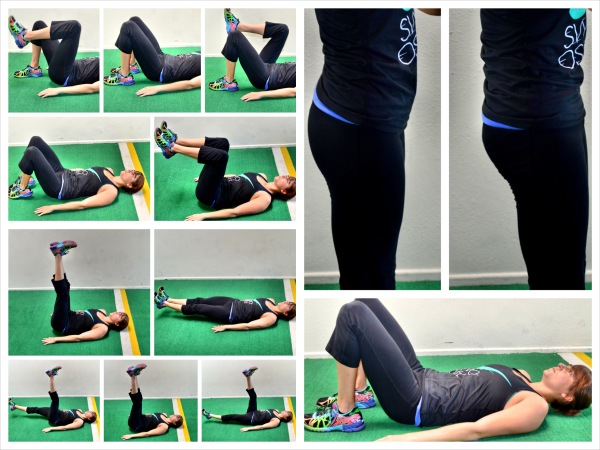
Learn more about the Pelvic Tilt Progression here.
Plank Workout – The 5-Minute Core Burn Out
If you’re planks are strong and you are ready to get in a killer core burn out at the end of your workout, try this 5-minute follow-along workout!
Get 9 MORE 5-Minute Burnouts!
If you love this follow along workout, you’ll love my Bodyweight Burner DVD! It has 9 5-minute follow along workouts to work EVERYTHING. And no equipment is required! Whether you want a full-body workout, to tone those abs and arms OR to activate and work those glutes, there is a burner follow along for you!

